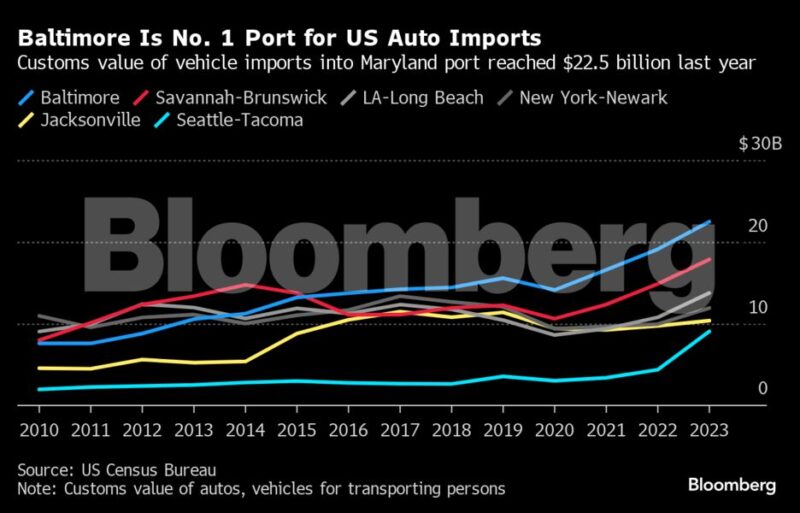Crew Rescued In Red Sea After Attack On Ship Near Yemen
CAIRO, July 6 (Reuters) – The crew of a ship set on fire in an attack in the Red Sea on Sunday abandoned the vessel and were rescued as it took on water, a British maritime agency said, in...
By Brendan Murray (Bloomberg) The bridge collapse Tuesday that shut the Port of Baltimore and closed a major highway will cause weeks or months of transportation disruptions in the Mid-Atlantic region and accelerate a shift of cargo to the US West Coast as importers and exporters try to avoid potential bottlenecks at trade gateways from Boston to Miami.
“Companies have already begun shifting volumes from the East Coast to the West Coast,” said Ryan Petersen, the founder and chief executive of Flexport Inc., a digital freight platform based in San Francisco. “Baltimore being taken offline means all the other ports on the East Coast are getting this bubble of cargo — creating congestion and delays.”
That also means companies and consumers may face a repeat of one of the big supply chain lessons of the Covid pandemic: that a sudden 10% or 20% increase in volumes through a port “is enough to cause massive backlogs, congestion, ships waiting offshore and all sorts of delays that can compound on themselves,” Petersen said.
As local, state and federal officials focus on rescue efforts and wouldn’t speculate on how long the nation’s busiest automobile port might stay closed, logistics experts and economists started to assess the fallout. The emerging consensus: It’s going to be a logistical choke-point for a while, but a localized one that shouldn’t derail an otherwise solid US economy, with companies able to adapt.
European carmakers including BMW AG, Volkswagen AG and Mercedes-Benz Group AG have facilities in and around the port to handle vehicle shipments. Ford Motor Co. said it’s already trying to find alternative routes, as is General Motors Co.
“It’s a large port with a lot of flow through it, so it’s going to have an impact,” John Lawler, Ford’s chief financial officer, told Bloomberg TV. “We’ll work on the workarounds. We’ll have to divert parts to other ports along the East Coast or elsewhere in the country.”

According to Dean Croke, principal industry analyst at DAT Freight & Analytics, Baltimore is one of the nation’s leading gateways for farm equipment and construction machines like combines, tractors, hay balers, excavators and backhoes.
March “is the peak import month in Baltimore for farming equipment ahead of planting season in the Midwest,” Croke said. It’s also a key port for construction materials like lumber and gypsum, he said.
Everstream Analytics, a supply-chain risk assessment firm, said the port is also a critical hub for items like steel, aluminum and sugar, with some 30 to 40 container carriers stopping there each week.
The transport of up to 2.5 million tons of coal may be blocked, according to Xcoal Energy & Resources LLC.
A.P. Moller-Maersk A/S, the world’s No. 2 shipping line — which had chartered the vessel involved in the bridge disaster from another operator — is omitting Baltimore on all its services for the foreseeable future.
The following are some further initial perspectives from logistics experts:
Tuesday’s disaster comes against a backdrop of a global logistics system that already faced significant strains from dynamics including war and climactic conditions.
“Far East-to-US East Coast ocean freight services have already been impacted by drought in the Panama Canal and recent conflict in the Red Sea,” Emily Stausbøll, an analyst at Oslo-based shipping-analytics company Xeneta, said in a statement. Those factors already saw rates increase by 150%, and now “this latest incident will add to those concerns,” she said.
The initial take from economists was that the impact of the disaster will be limited.
With Interstate 695 knocked out by the bridge, I-95 or I-895 will see higher traffic for the foreseeable future, Oxford Economics said.
As for how long that future is, Peterson at Flexport — which had two containers on the ship that struck the bridge and a few hundred more on ships headed to Baltimore — said the timetable for full recovery was “probably months.”
“But sometimes these people work miracles,” he added.
By Brendan Murray, Augusta Saraiva and Enda Curran © 2024 Bloomberg L.P.

Sign up for gCaptain’s newsletter and never miss an update

Subscribe to gCaptain Daily and stay informed with the latest global maritime and offshore news


Stay informed with the latest maritime and offshore news, delivered daily straight to your inbox
Essential news coupled with the finest maritime content sourced from across the globe.
Sign Up